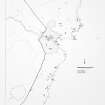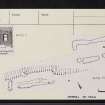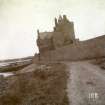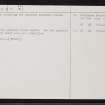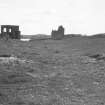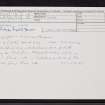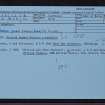Ackergill Links
Long Cist Cemetery (Pictish), Pictish Symbol Stone(S) (Pictish)
Site Name Ackergill Links
Classification Long Cist Cemetery (Pictish), Pictish Symbol Stone(S) (Pictish)
Alternative Name(s) Wic 130a & 130b
Canmore ID 9243
Site Number ND35SW 12
NGR ND 3487 5497
Datum OSGB36 - NGR
Permalink http://canmore.org.uk/site/9243
- Council Highland
- Parish Wick
- Former Region Highland
- Former District Caithness
- Former County Caithness
Ackergill 1, Caithness, Pictish symbol stone
Measurements: L 1.22m, W 0.61m, D 0.08m
Stone type: Caithness flagstone
Place of discovery: ND 3483 5499
Present location: National Museums Scotland, Edinburgh (IB 168)
Evidence for discovery: found in August 1896 by John Nicholson on a mound on the links beside Sinclair’s Bay. It was given to the museum in 1897.
Present condition: slab has flaked but the surviving carving is crisp.
Description
The broad smooth face of the slab is finely pecked with a large rectangle symbol containing spiral ornament, above which is the lower part of a fish with two fins. To the left of the symbols and cut at an acute angle to them is an ogham inscription reading NEHTETRI.
Date: eighth century.
Desk-based information compiled by A Ritchie 2016
Ackergill 2, Caithness, Pictish symbol stone fragment
Measurements: H 0.31m, W 0.42m, D 0.04m
Stone type: slate
Place of discovery: ND 3483 5499
Present location: National Museums Scotland, Edinburgh (IB 206)
Evidence for discovery: found during excavations in 1925, ‘lying on the surface’ near the head end of a disturbed long cist.
Present condition: broken but the carving is crisp.
Description
This fragment is part of a symbol stone and is finely pecked with a rectangle symbol. The rectangle has a notch in one long side, a median line and two curving lines.
Date: seventh century.
Desk-based information compiled by A Ritchie 2016
Field Visit (21 April 1963)
The mound is about 120m long with a maximum width of 27m and 2m high. It has been considerably mutilated by World War 2 defence works, so that the many depressions in the mound cannot be positively identified with the 1925-6 excavation trenches.
Visited by OS (R D L) 21 April 1963.
Desk Based Assessment (1963)
ND35SW 12 3489 5496
(ND 3489 5496) Dark Age Burial Ground (NR) (site of)
Symbol Stones found (NAT)
OS 25" map, (1965).
A linear inhumation cemetery in a natural, elongated, sand mound was excavated in 1925 and 1926 by Edwards who found sixteen burials in ten separate graves. All except one of the burials were extended inhumations, and, again excepting one, none was accompanied by grave goods. Most were in long cists, about 6ft in length and 1ft 6ins in breath and height, covered by low, rectangular, kerbed deposits of stone.
The mound, cut 400ft from its NW end by the drain from the decoy pond at ND 3493 5494, had also been cut lengthwise by a road, during the construction of which human remains had been found. For a distance of about 200ft from its NW end the mound was heavily eroded exposing stones including edge-set slabs, but the remainder was still turf-covered. An Ogham-inscribed Class I symbol stone had formerly stood erect at the NW end of the mound, and a fragment of another was found on the surface at its centre.
Graves 1 and 7 (on Edward's 1926 plans) were simple long cists. Graves 2, 3, 4, 8, 9 and 10 were rectangular or square kerbed deposits of stone ranging in area from 6ft by 7ft to 12ft square, and in height from 1ft to 1ft 9ins, either incorporating (graves 2 and 4) or overlying long cists. In some of these structures the corners were accentuated by upright stones or large slabs (graves 2, 3 and 4) and the mid-points of the N and S sides of grave 4 were similarly accentuated. Graves 3 and 4 were covered by a layer of white quartzite pebbles. Graves 5 and 6 were apparently more sophisticated than the others although they possessed enough points of similarity to suggest kinship.
Grave 5 was, in effect, a sub-oval built chamber 10ft NW-SE by 3ft 6ins across and 1ft 6ins high with walls 5 to 7ft thick kerbed externally by a 20 by 13ft 6ins rectangular setting of large slabs on edge, the corners and the mid-points of the long sides being accentuated. The chamber was divided by edge-set slabs, 1ft high, to form two adjoining long cists, slab-covered. Apart from a slight corbelling of the walls there was nothing to suggest that the chamber had been roofed; in fact the contrary was suggested by the wall-tops having been over- laid by white quartzite pebbles.
Grave 6, at the NW end of the mound and on the N side of the road, differed from the others in its cairn-like form and in mode of burial but there were similarities between it and grave 5. It was circular, 18ft in diameter, and consisted of a sub-oval, built chamber 7ft 3ins long ENE-WSW by 4ft across and 3ft 3ins high, within a wall 5 to 7ft thick with an external built kerb 1 to 2ft high. As in grave 5, the chamber wall was slightly corbelled, but otherwise there was no evidence of its being roofed. White quartzite pebbles, possibly fallen from the sloping sides of the structure, lay near the kerb on the SE side. The chamber was filled with sand and contained four uncisted skeletons, the earliest being than of an elderly man lying extended on the floor of the chamber. At a slightly higher level was the extended skeleton of a young person about 15 years old. Very slightly above this, on a level with the top of the side walls, was a flexed skeleton of a middle-aged man, and at approximately the same level was the extended skeleton of a female, a little over 20 years old with, around the neck, a possibly 10th century bronze chain 15 3/4ins long, with iron rust adhering to one of its terminals. The site of this grave was marked by a notice prohibiting the removal of sand.
In the same locaility a similar structure, 16 1/2ft in diameter with a well-defined kerb surrounding a cairn-like mass of stones, 3 1/2ft high, was discovered in 1902 (information from John Nicolson, Nybster), and a circular construction, 15ft in diameter, some years before 1925 (information from Simon Bremnar, Feswick).
Analysis of the skeletal remains from the cemetery indicated that the burials were of both sexes and of all ages from babies to the elderly; and that the people were dolichocephalic and lightly built, averaging in height only 5ft 5ins for males and 5ft for females. The conclusion was that they belonged to a native population of mixed origin, such as occupied the north of Scotland in the Viking period (Edwards 1926).
The Ogham-inscribed symbol stone, which formerly stood upright at ND 3483 5499 (information from Mrs Duff-Dunbar, Ackergill), was found, broken, on the links towards the S side of Keiss Bay in August 1896 by John Nicolson, Nybster, who brought it to Sir Francis Tress Barry at Keiss Castle, who in turn donated it to the NMAS in 1897 (Accession no: IB 168). It is a slab of grey slate, 4ft long, 2ft broad and 3ins thick with, incised on one face, the lower part of the fish symbol and the rectangular symbol, divided and decorated with spirals. The Ogham inscription has been read as 'NEHTETRI' and translated as 'Neht, son of Etrios'.
The other symbol stone fragment was found on the surface near the head of grave 1, about ND 3487 5497. It measures 12 1/2ins high, 16 1/2ins wide and 1 5/8ins thick and bears, incised on one face, a rectangular symbol and part of another. It, together with other finds from the excavations and a polished stone disc, 2 5/8ins in diameter, found on the surface of the mound, was donated to the National Museum of Antiquities of Scotland (NMAS) by Mrs Duff-Dunbar of Ackergill.
Certain features of this site, eg. the accentuation of the corners of the rectangular kerbed structures and the occurrence of symbol stones, have been compared with other extended inhumation cemeteries, either proved or supposed, eg. Garbeg (NH53SW 15), Whitebridge (NH41NE 2), Lundin Links (NO40SW ) etc, and with single graves, eg. Golspie (NC80SW 16), but the closest parallel is possibly with the cist cemetery at Stain (ND36SW 5). The occurrence of the Class I symbol stones and the comparison with the Golspie and Lundin Links graves would suggest an earlier date for the cemetery than that suggested by the possibly 10th century necklace.
J Anderson 1897; J R Allen and J Anderson 1903; A J H Edwards and T H Bryce 1926; A J H Edwards 1927; T H Bryce 1927; J Close-Brooks 1981; P Ashmore 1981.
Photographs in Inverness Museum
Cist 4 (1902) skull only N/N 977.P79.24.
Unidentified and unlabelled picture of skull. May be that from Ackergill Links, cist 4 as it is filed with a labelled picture of the skull from that site. 977.P79.25
Information from OS.
External Reference (1980)
No. 2 This fragment of clay slate is much weathered, and measures 0.3m x 0.42m x 0.03m. A notched rectangular symbol is discernible decorated inside with a trumpet-like shape above a horizontal divide.
Donated to the Royal Museum of Scotland (RMS, formerly the National Museum of Antiquities of Scotland [NMAS]) by Mrs Duff-Dunbar in 1925. Acc No IB 206. Information from R Jones 1980.
Field Visit (1981)
Active erosion revealing two separate possible graves.
C E Batey 1981.
Field Visit (17 July 1982)
No change to the previous field report. The two possible graves noted by Batey were not identified.
Visited by OS (J M) 17 July 1982.
Excavation (December 2003)
ND 3487 5497 A survey was undertaken in December 2003 to the NW of Ackergill Tower. This followed the discovery of human bones after mechanical excavation on the site of a known linear inhumation cemetery, partially excavated by Arthur J H Edwards in the 1920s (PSAS 60, 160-82), and attributed to the mid-1st millennium AD.
A number of human and animal bones were recovered from spoil heaps surrounding the area of disturbance and at the base of the excavated area. The human bone appeared to derive from one or more disturbed graves. In addition, parts of various stone-founded structures were recorded. These were visible across parts of the mound which had not been subjected to quarrying, but badly degraded by rabbit warrens.
During a second phase of work in April 2004, 31 finds of animal bone were made, together with three finds of human bone. A contour survey of the mound was also conducted. The human bone is considered to derive from the known linear inhumation cemetery. The animal bone appears to be modern.
Archive to be deposited in the NMRS.
Sponsor: HS.
A Hunter Blair 2004.


























































